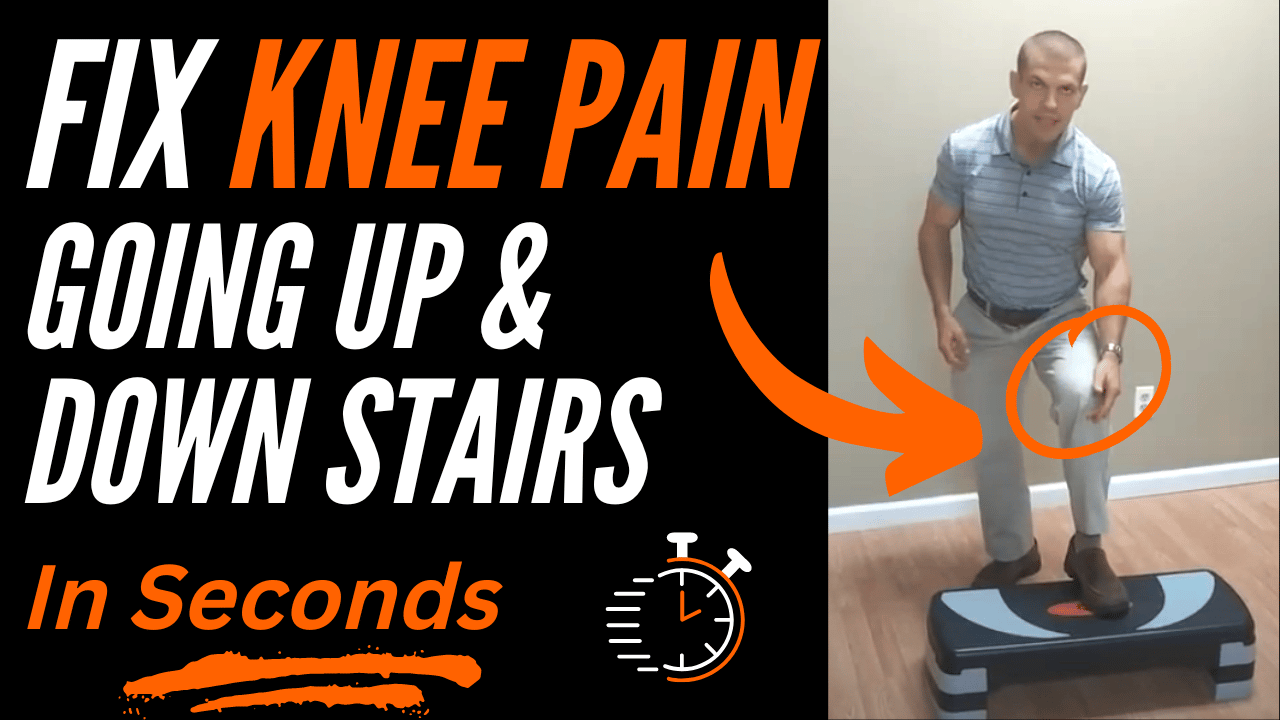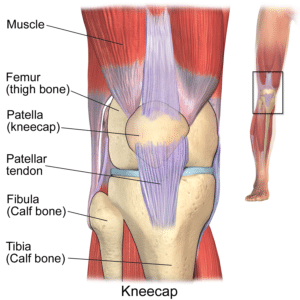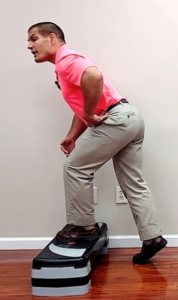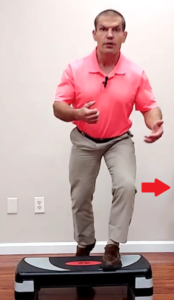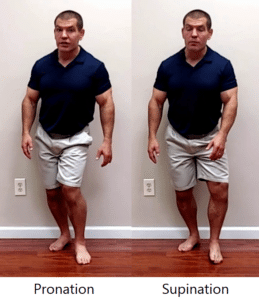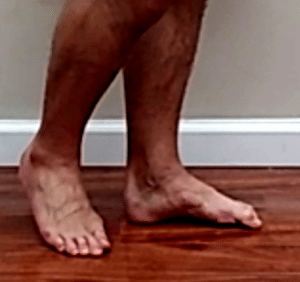Do You Get Knee Pain Going Up And Down Stairs?
Watch the video below to learn what it means when your knee hurts going up and down stairs, plus how to relieve knee pain climbing stairs. Then watch the video further down on this page to learn how to relieve knee pain going down stairs.
What Does It Mean If Your Knee Hurts Going Up And Down Stairs?
Knee pain when going up and down stairs is one of the most common complaints among people who suffer from all different types of knee pain:
Going up and down stairs may cause pain on the outside of the knee, pain on the inner part of the knee, or on the front of the knee.
Don't worry though.
Just because your knee hurts going up and down stairs doesn't mean that there's a serious problem.
In most cases, just a few simple changes to the way that you go up and down stairs can significantly decrease your knee pain.
Knee Pain Going Up And Down Stairs Is Common But It's Not Normal
Most people have to go up and down stairs almost daily, even if it's only one or two steps to get into the house.
Having difficulty going up and down stairs can be extremely limiting in your daily activities.
Sure, if you only have pain in one knee, you can just walk up the stairs one step at at time...
"Up with the good, down with the bad" as the saying goes
That's a good workaround for awhile, but it's still not "normal".
Remember the days when you could just go up and down the stairs easily without thinking about it?
In this post, I'm going to give you some simple tips to fix knee pain going up and down stairs.
How to fix knee pain going up stairs
How to fix knee pain going down stairs
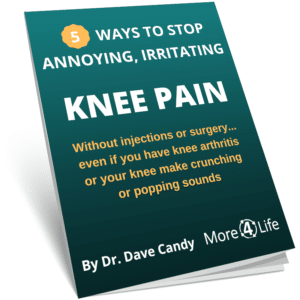
How To Fix Knee Pain Going Up Stairs
Technique Matters When Walking Up Stairs
First, let’s look at HOW you place your foot on the stair. I commonly find that when people have knee pain going up stairs, they put their toes on the stair first.
Putting weight on your toes first activates the thigh muscles (quadriceps).
When you use your quadriceps too much, it compresses your kneecap (patella) against your thigh bone (femur). This can create a grinding, "bone-on-bone" kind of pain.
This kneecap on thigh pain, called patellofemoral pain, can create a feeling of instability. It may even feel like your knee is going to lock up or give out on you.
Chances are it probably won’t.
However, it can be scary feeling that your knee is going to give out when you're on the stairs. This is especially if you've fallen on the stairs before.
Wouldn’t it be nice if there was a way to safely and confidently climb stairs without hurting knees?
Well, there is!
Small Changes Can Make A Big Difference In Knee Pain Going Up Stairs!
Here's one example:
When walking up stairs, place your WHOLE FOOT on the stair and shifting your weight toward the back outside edge of the foot.
This will help you activate your glutes (a.ka. your "butt muscles").
If you lean forward as you place your foot on the stair, you can use your hip and buttock muscles to push your body up the stairs without your knees hurting.
Hip, Knee, & Foot Alignment Matters
Another problem I commonly see when people have knee pain going up stairs is a misalignment of the knee and foot.
When you place your foot on the stair, the knee should align directly over the foot without falling inward.
Like a pillar that supports a building, you want your leg to be a vertical line. That way, when you step up, your body is well-supported.
When your knee and leg fall inward toward the midline of the body, this can cause pain on the inner or outer part of the knee.
Your Foot Plays A Big Role In Knee Pain When Climbing Stairs
When your knee falls inward it causes your foot to flatten or to "pronate".
You can correct this by placing weight on the OUTSIDE of the heel.
Your Hips And Back Affect Knee Pain Too
If your knee is falling in, it could be caused by weakness in your hips. Or perhaps you have an old back issue that never completely resolved.
Making an arch in your foot as you place it on the stair will help you keep your knee in alignment.
This helps you avoid knee pain going up the stairs. You can do this by scrunching your toes and making a dome shape under your foot.
Proper Arch Support Can Help Prevent Knee Pain Going Up Stairs
If it feels new or difficult for you to keep your foot/arch lifted, then you may benefit from wearing shoes with good arch support.
Yes, even inside the house.
(You can have a special "inside" pair of shoes if you're worried about dirt.)
Make sure the shoes have good arch support built in, or put in an off-the-shelf orthotic or custom orthotic in them. This will help you keep your hip and knee in good alignment and prevent knee pain walking up stairs.
Follow These Tips To Relieve Knee Pain Going Up Stairs:
-
Place your WHOLE FOOT on the stair, not just your toes. When you place just your toes on the stair, you activate your thigh muscles. The thigh muscles compress your knee cap and can cause a bone-on-bone pain sensation.
-
Placing weight on your whole foot and pushing through the OUTSIDE OF THE HEEL activates your butt muscles. This will allows you to push up more easily.
-
Make sure your knee is aligned directly OVER your foot and not falling inward. That can cause inner and outer knee pain going up stairs since your leg isn’t properly aligned.
-
As you place your foot on the stair, create an arch in the foot by scrunching the middle of your foot up and creating a small dome under the inner bottom of the foot. That will direct weight to the OUTSIDE of your foot and especially into your heel.
-
Keep in mind, if there's misalignment of the foot, then there could be some weakness in the hips or even the back. If no one has ever ruled these out as factors contributing to your knee pain, it would be wise to have them checked out before considering any type of knee surgery or other invasive treatment.
Need Help For Knee Pain?
Tap the button below to request an appointment with one of our specialists.
What If I Have Knee Pain Going Down Stairs But Not Upstairs?
Many people with knee pain and knee arthritis actually have knee pain going down stairs but not upstairs.
This seems counter-intuitive because you would think that going stairs down would be easier. After all, gravity is helping you when you go down stairs, but you have to fight gravity going up stairs.
However, your muscles actually have to work harder when lowering a weight (in this case your bodyweight) than they do lifting the weight.
This can increased muscle tension in your quadriceps muscles can cause a sharp, stabbing pain in your knee that makes it feel like your leg is going to give out.
This can be scary when you're going down stairs, because you definitely don't want to fall down the stairs.
Fortunately, a few simple changes can help you stop knee pain going down stairs!
Watch the video below for tips on how to prevent knee pain when going down stairs...
Follow These Tips To Fix Knee Pain Going Down Stairs:
-
Place the ball of your foot and your toes slightly over the edge of the step.
This allows you to "roll over" the edge of the step so your knee doesn't have to bend as much. This is particularly helpful in relieving knee pain going down the stairs if you have a stiff ankle joint or tight calves. -
Let Gravity Do The Work
Going down the stairs fast is actually MUCH easier than going down them slow. When you just let your knee unlock and drop down the the stairs, the leg that you are standing on doesn't have to do any work. Gravity literally pulls you down to the next step.But it can be scary to do this when you have knee pain because you have to trust that the other leg is going to catch you. This is especially true if you've fallen on the stairs before.
Because of this fear, you go down the stairs slowly. This actually requires the leg that you're standing on and bending to have to fight gravity. This in turn causes the knee to hurt and feel unstable, which makes you even more fearful!
So, you go down the stairs even more guarded the next time, but that causes even more knee pain.
But if you can get over the fear and just try to go down the stairs faster, it's likely that you'll have less knee pain going down the stairs!
-
Don't forget about your ankles and hips. As mentioned above, hip weakness and/or ankle flexibility can make your knees hurt when going down stairs.
-
Often the knee is just the thing in the middle of the hip and ankle problem that ends up hurting. But the knee is RARELY the primary problem.
If no one has ever ruled out your hip or ankle out as factors contributing to your knee pain, we'd be happy to offer you a FREE Discovery Visit in the office so that you can find out what's wrong, and what you can do to be able to go up and down the stairs without knee pain.
Want More Useful Tips on How To Keep Your Knees Healthy
Click the button below to download our FREE Knee Pain Guide

It Gets Harder When You Carry Things Up And Down Stairs
As if going up and down stairs wasn't challenging enough if you suffer from knee pain or knee arthritis, carrying things can make it even more difficult.
Carrying a laundry basket up or down stairs is a common example that I hear about from my clients. Since it's big and bulky, you have to carry it with both hands. Thus, you can't hold on to the handrail for balance.
If you've got knee pain, balance is important because you don't want to fall down the stairs. This fear can cause you to come up with creative, but awkward, solutions in order to avoid falling.
I've had clients tell me that when going down stairs, they have to throw the laundry bag down first. Then they walk down using the handrail.
When going up stairs, they put the laundry basket up a few steps. They walk up, then put it up a few more steps, and then walk up again, etc.
These solutions are a good workaround for a short period of time, but they're not good long-term solutions.
Simply put, you should be able to carry things up and down stairs without knee pain and without fear of falling.
How To Tell When To Get Help For Knee Pain Going Up And Down Stairs
An occasional twinge when going up or down stairs is OK, as long as it doesn't persist.
However, if you've been consistently having knee pain going up and down stairs for more than a a month it would be a good idea to get it checked out.
If you read the paragraph above and rolled your eyes because your knees have been bothering you when climbing stairs for a year, or 2 years, or 10 years or more, then it's well past time to get things checked out.
"But I've Already Had It Checked Out... I have Knee Arthritis"
It's a common believe that if you have knee arthritis, that you're destined to either live in pain or have a knee replacement.
Maybe your doctor has told you:
-
That your knees are "bone-on-bone"
-
That you're just getting older, and you'll have to deal with the pain
-
Or perhaps, that you'll need a total knee replacement
We love helping people relieve knee pain and avoid surgeries, even if they’ve been told that they have knee arthritis or have "bone-on-bone" show up on their x-ray. Tap the button below to find out how our specialists can help you.
Here are some other posts about how to relieve knee pain that you might enjoy:
Do You Get Knee Pain At Night While Sleeping? Check out our post on "How To Relieve Back Pain, Hip Pain, & Knee Pain At Night While Sleeping"!
Do You Get Knee When Sitting For Long Periods? Check out our post on "How To Relieve Knee Pain When Sitting For Long Periods"!
Do You Get Knee Pain When Standing Up From Sitting? Check Our our post on "How To Stand Up From Sitting Without Knee Pain"!
Do You Get Knee Pain When Squatting? Check Our our post on "How To Squat Without Knee Pain"!

